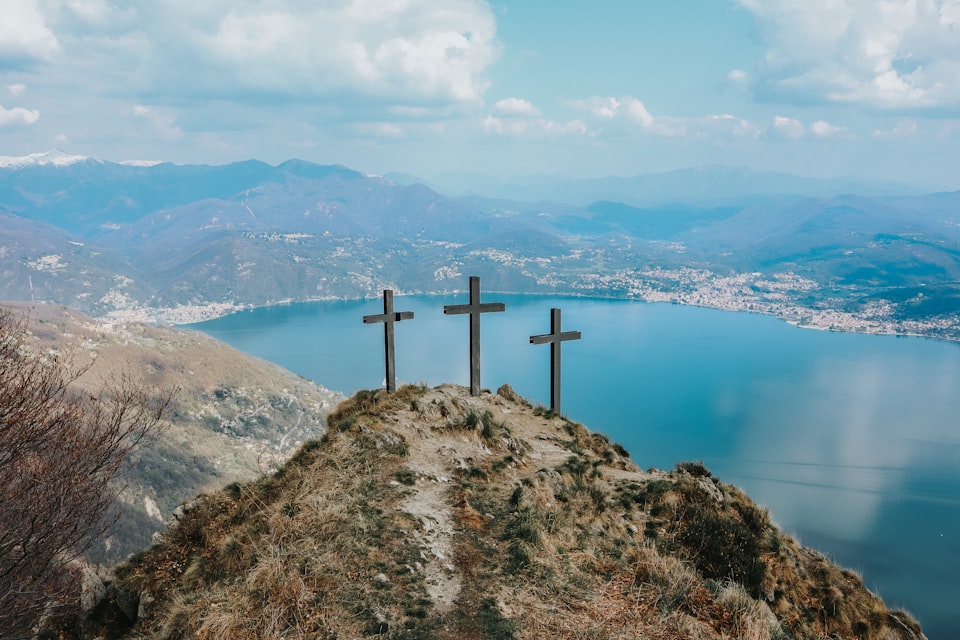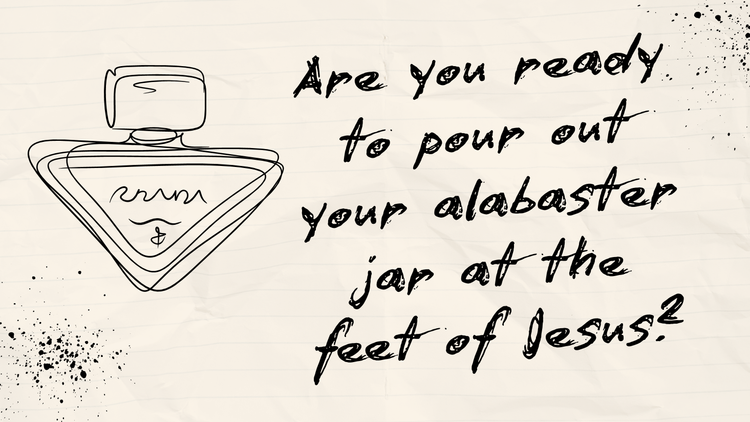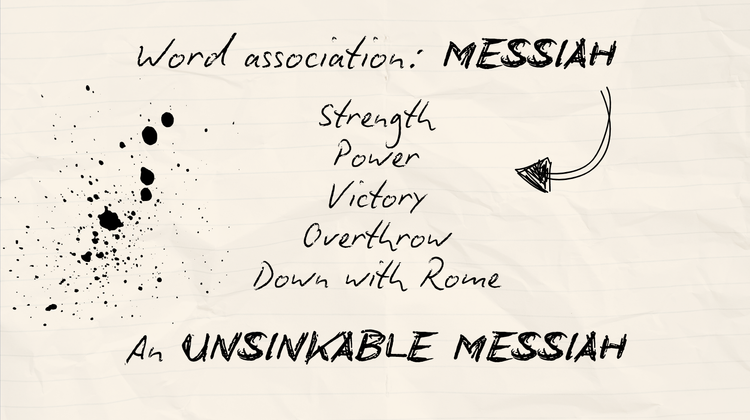In the Middle

Earlier this week, I shared with you "Two Amazing Truths," so please take a look at that if you haven't already.
Today, I share two more excerpts from my book entitled Mark's Unfinished Story. Please continue using these to reflect on the upcoming passion week.
One on his right and one on his left
They crucified two rebels with him,
one on his right and one on his left.
—Mark 15:27
Earlier in his gospel, Marks tells the story of James and John, the sons of Zebedee. “Teacher,” they said to Jesus, “we want you to do for us whatever we ask” (Mk 10:35). My initial reaction is, “Come on, guys, stop being so childish! You know better than that!” And then I am quickly reminded of how often my prayers are precisely like that, though I never say those exact words.
“Lord, please help me…please be with me…”
And then it doesn’t take long before my words devolve into:
“Lord, I need this…do this for me…bless my plan…give me good things…” and so on.
Continuing in Mark 10:36-45 (paraphrased):
“What do you want me to do for you?" Jesus asked.
“We want to be the ones to sit at your right and left hand in glory. Come on! Whaddaya say?” they respond with great enthusiasm.
“You have no idea what you are asking for,” Jesus says. “Are you ready to drink the cup I will drink or be baptized as I will be?”
“Absolutely!” Of course, neither James nor John knew that Jesus was talking about a cup of suffering or a baptism of death.
“Well,” Jesus continued, “you will drink this cup, and you will be baptized with this same baptism, but sitting at my right or left hand? That’s not for me to decide. These places belong to those who are being prepared for those places.”
Later, when talking with all of the disciples, Jesus said, “Whoever wants to become great must become a servant, and whoever wants to be first must become a slave to everyone. Even the Son of Man did not come to be served, but to serve, and to give his life for a ransom for many.”
Jesus came to live among humanity; the same humanity that, time after time turns its back on him. Moving quickly forward to the cross, this same Jesus who ate with sinners and tax collectors, who touched the sick, spoke kindly to the lowest people in society, and wept over the masses of people who were like sheep without a shepherd, is now hanging on the cross between two men.
Jesus fits into the first category of showing chutzpah on behalf of others, like Abraham, David, and Moses. He pleaded for God’s mercy on the perpetrators of his crucifixion, because “they do not know what they are doing.”
– Lois Tverberg, “Dust of the Rabbi” (Kindle 1994)
Who are these men at his right and left hand? It’s not James, and it’s not John. It’s not any of the disciples, for they have all fled. Jesus hangs on the cross between two rebels, criminals who “heaped insults on him” and everyone else. The irony of the situation, compared to the earlier scene with James and John, cannot be ignored.
In Mark’s simple picture of the crucifixion, we see that Jesus not only died for humanity, but he also died with humanity and as a part of humanity. Those two nameless figures crucified on the right and left of Jesus represent me, you, and every man, woman, boy, and girl on the planet. We are the sinners, the outsiders, and the ones in need of forgiveness.

An Empty Tomb and a Strange Conversation
When the Sabbath was over, Mary Magdalene, Mary the mother of James, and Salome bought spices so that they might go to anoint Jesus’ body. Very early on the first day of the week, just after sunrise, they were on their way to the tomb and they asked each other, “Who will roll the stone away from the entrance of the tomb?”
But when they looked up, they saw that the stone, which was very large, had been rolled away. As they entered the tomb, they saw a young man dressed in a white robe sitting on the right side, and they were alarmed.
“Don’t be alarmed,” he said. “You are looking for Jesus the Nazarene, who was crucified. He has risen! He is not here. See the place where they laid him. But go, tell his disciples and Peter, “He is going ahead of you into Galilee. There you will see him, just as he told you.”
– Mark 16:1-7
The tomb is empty.
Jesus was not there.
This wasn’t supposed to happen.
Dead people stay in their tombs.
But this tomb is empty.
Sabbath prohibitions had allowed time only to wrap the body Friday afternoon before the Sabbath, so the women needed to get to the tomb as early as possible to complete the washing and anointing of the body.
So, after a long, likely sleepless Friday night and Sabbath, the women rose early to go to the tomb, hoping that the stench of rapid decomposition in the hot Mediterranean days might have been mitigated adequately by the two-thousand-foot elevation of Jerusalem in April combined with a sealed tomb.
With spices in hand, possibly purchased the previous evening after the Sabbath had ended, they approach the tomb, wondering who might be around to help them roll the stone away. As they approach the tomb, they see that the stone has been rolled away.
Has someone else come to anoint the body?
Has Joseph returned to his tomb to ensure that all is well, given that everything happened so quickly Friday evening?
The women came to the tomb prepared to deal with a dead body. I think we can be sure that an empty tomb was not even on their radar.
Entering the tomb, a young man dressed in white frightens them. The tomb was not empty, but the one they expected to see was not there.
“Don’t be afraid,” the young man says to them,…
Translation: Don’t freak out! Take a deep breath. Everything is going to be okay.
“You are looking for Jesus the Nazarene…
Translation: Yes, they were in the right tomb.
… who was crucified…
Translation: Yes, he really was dead.
…He has risen…
Translation: Here’s the breaking news—HE IS NO LONGER DEAD! Yes, that is correct.
…He is not here…
Translation: As you can plainly see.
… See the place where they laid him…
Translation: Yes, he’s definitely not there.
…But go, tell his disciples and Peter that Jesus is going ahead of you into Galilee…
Translation: That’s right, there will be no burial preparations here today. Instead, you will be the first to proclaim this news about Jesus. Get movin’!
…There you will see him…
Translation: He is not here. Go to where he is. When you get there, you will see him. And when you do, your life will never be the same again.
The Bible does not offer a neatly folded map or “a perfect plan for your life” or a bottle-fed blueprint for living. The good news was not a new set of laws or a new set of ethical injunctions or a new and better seven-point PLAN.
The good news was the story of a victory that had already been won by the person of Jesus the Christ. The good news is glad tidings of a beautiful new relationship between humans and the divine: God so loved the world… Christ so redeemed the world…The Holy Spirit so pervades the world…That a new world is coming. That’s the GOOD NEWS!
Leonard Sweet, “So Beautiful” (Kindle 2243)
Peter would become a key figure as the story moves forward from here. By way of the young man’s message to the women, Peter and the other failed disciples are welcomed back into a shalom-based relationship with Jesus. They are invited to rejoin him in his mission.
Judas is left out, for obvious reasons, but I can’t help but wonder what a reunion of Judas and Jesus might have looked like had Judas not ended his life. Can you imagine what that scene would have looked like?
I think it would have been epic.
I hope you have enjoyed the excerpt from Mark's Unfinished Story.
Please comment below and share this story link on Facebook, Instagram, Twitter, email, or whatever social media you use. Here's the link:
www.doeverythinginlove.com/in-the-middle/







Member discussion